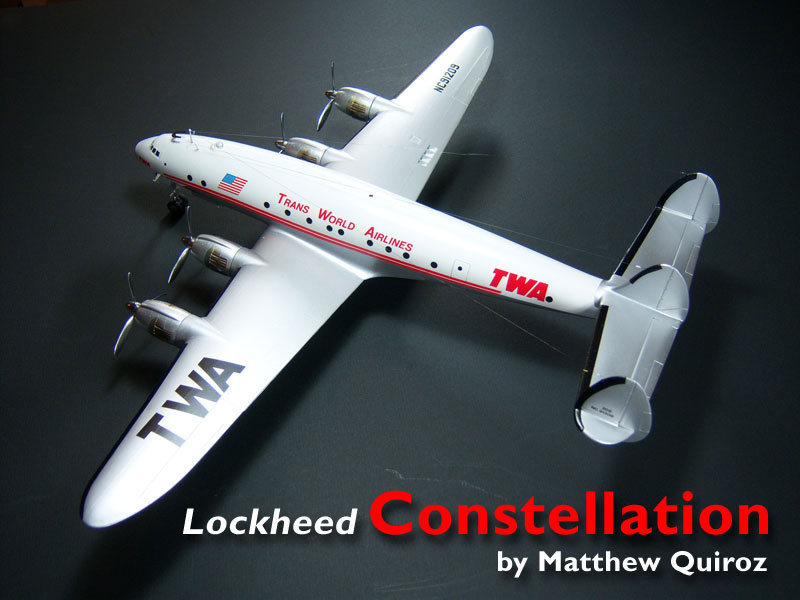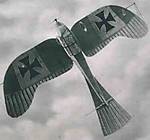1⁄72Lockheed Constellation
7
Comments
History and Background
While I am not old enough to have flown on or seen a flying Constellation, I believe it is one of the most beautiful aircraft to have ever flown the skies. I never really paid much attention to the airplane as a young modeler as it just didn’t appeal to me. It had a long skinny fuselage, triple tail, long landing gear. It was pretty blah to a kid who was into WWII fighters and tanks. It didn’t have camouflage, bombs, or guns so therefore, I paid it no mind. What was I thinking? That was many years ago mind you. Fast forward to a few years ago and I’m sitting in the basement at a friend’s house and pick up a book entirely devoted to the Connie. I could not put the book down and over the course of the next several hours, I poured over every page. Civilian and military versions, airliners, Warning Stars, this book had it all. I was amazed to say the least and thus began my fascination with this wonderful plane.Conceived by the shrewd businessman Howard Hughes in the late 1930’s the Lockheed Constellation or Connie as she is more commonly referred to, celebrated her 60th birthday in 2003. At the time, the Constellation represented the ultimate in airline performance and luxury with 856 being built in the 1950’s for commercial and military customers. She was quickly displaced from frontline service by jet airliners in the 1960’s, with the entrance of faster jet aircraft. However, there are at least fifty-five “survivors” that avoided being scrapped in the 1960’s and 70’s, and two are still flying regularly on the air-show circuit today with more being restored to near or flyable condition as we speak.
Designed specifically for Transcontinental and Western Airlines (TWA) in 1939, the Lockheed Model 49 "Constellation" was first flown in 1943 and almost immediately commandeered by the US Army Air Force for use as a VIP transport and titled as C-69. When first flown as the USAAF C-69, the four engined, 40 ton Connie was faster than the Japanese A6M “Zero” fighter! She would get even faster and more refined as she aged.
All Connie’s coming off the production lines until the end of WWII in 1945 bought by the military as the Army model C-69 with various civilian airlines being contracted to fly them. The Connie shared the same troublesome power plant as that used in the Boeing B-29; the Wright R-3350 Cyclone, a massive, twin row, supercharged, air-cooled, radial engine with 18 cylinders producing 2200 HP and eventually 3700 HP. As a result, the Connie suffered the same problems; overheating, engine fires, etc. At one point, Lockheed accused Wright Aeronautical of failing to properly engineer, build and inspect the engine and rather than consider a Lockheed proposal to switch to Pratt-Whitney R-2800 engines, production of the C-69 was halted while engineers tried to work out the bugs of the Wright Cyclone. These problems slowed the evolution of the Connie several times over the course of the years. Not helping matters any was that the Army assigned a low priority to the C-69. The end result being the Connie finished the war with many of its problems still needing to be addressed.
During its twelve year production run after the war, a total of sixteen civilian model designations were assigned to the Constellation starting with the original model 49 and progressing through model 1649 in increments of 100 (superstition dictated the omission of “1349"). Less than one third of these ever got off the drawing boards, but some that did, had a sub variant designation assigned of "-A", "-B" etc. However, several of these sub variants failed to go into production. As it stands, the major civilian Constellation models read: 49, 649, 749A, 1049, 1049C, 1049G or Super “G”, 1049H and 1649A. The models 1049 were officially and aptly known as the "Super Constellation", and the 1649A as the "Starliner".
May 1955 saw work begin on the model 1649 with the aircraft still retaining the “Super Constellation” moniker. Shortly there-after, it was renamed the "Super Star Constellation" and finally the "Starliner". The 1649 became the definitive Constellation as it featured a new, longer, narrower wing based on the design of the equally successful Lockheed P-38, which provided for 9,278 gallons of fuel, nearly double the fuel capacity of the first Connie. This also provided well over twice the range to over 5,400 miles with a maximum payload. With these modifications the Starliner could reach any European capitol non-stop from any major airport in the US while also being the fastest piston engined airliner at ranges over 4,000 miles ever built.
Creature comforts were abundant with cabin temperature control and ventilation being perfected from earlier models and seats that were fully reclining for comfort on long flights. The engines being set farther outboard on the longer wings meant less cabin noise. Noise was reduced further with the installation of new state of the art sound deadening materials. Everything about the Starliner was impressive; it made a handsome profit for the airlines, passengers flew in total comfort, and it was practically trouble free. But even as the new Connie was taking to the skies over her home in Burbank, the death knell was being sounded some 950 miles to the north. In the end, the Connie was felled by the fast developing technology of the jet engine, and in particular the Boeing 707 jet airliner.
Faster, larger, and more profitable aircraft have come and gone in the forty-odd years since her birth, but the "Connie" remains to this day one of the most recognizable and beautiful aircraft ever to have flown.
Comments
How cool. Just posted a week ago and already almost 1000 reads/views. Thanks all. "Q"
JUL 11, 2009 - 02:58 AM
I have never met anybody who did not like the Connie - and your build is superb as well.
JUL 11, 2009 - 04:25 AM
Hi Matthew
Apart from your Connie being a particularly fine build, the viewing total also shows there's a real interest and demand for civil subjects on Aeroscale. It's certainly an area I'd like to see get more coverage.
Keep 'em coming! All the best
Rowan
JUL 11, 2009 - 09:27 AM
Hey Matthew, just wanted to say great build. The Constellation is a beautiful bird and it is nice to see more civil stuff on here. I know I have said that before but just wanted to say it again. I have the same kit, it comes in Pan Am markings though I think. Great job. Russell
JUL 11, 2009 - 10:51 AM
Nice build Matthew, beautiful looking aircraft.
A short while ago I built the Super Connie in Qantas colours for a friend of mine, I am now in the process of building the L-749 Constellation, again in the Qantas Empire Airways scheme and also for the same friend (he worked on these aircraft way back in his younger days).
I'm very lucky to have access to a full size flying Super Connie only 15 minutes drive from my place. She has been fully restored back to the Qantas scheme and attends most of the airshows around the area. Looks absolutely beautiful in the air, especially when she comes in for a low high speed pass.
Thanks for the tips you have given during your build, they will be most helpful.
Cheers
Des.
Current projects;
Roden 1/32 de-Havilland DH-2
Wingnuts 1/32 Junkers J.1
Wingnuts 1/32 Bristol F.2b
and for my mate an L-749 Constellation from Heller
JUL 18, 2009 - 08:32 PM
Great build, Matthew! The finish is great especially on the metallic surfaces. Just the right shine and "feel" to it.
Thanks for sharing
JUL 30, 2009 - 01:02 AM
Copyright ©2021 by Matthew Quiroz. Images also by copyright holder unless otherwise noted. The views and opinions expressed herein are solely the views and opinions of the authors and/or contributors to this Web site and do not necessarily represent the views and/or opinions of AeroScale, KitMaker Network, or Silver Star Enterrpises. Images also by copyright holder unless otherwise noted. Opinions expressed are those of the author(s) and not necessarily those of AeroScale. All rights reserved. Originally published on: 2009-07-04 00:00:00. Unique Reads: 15283











